Sanctus Iacobus, Yago, Iago, Tiago, Thiago (Portuguese), Santyago, Santiago, Xacobo, Xacobe (Galician), Jacob, James (English), Jacques (French), Jaime (Catalan), Giacobo, Giacomo (Italian), Xaume, Jacome, Jaume, Jacobo, Diego, ܝܘܚܢܢ ܫܠܝܚܐ Yohanan Shliha (Aramaic), יוחנן בן זבדי Yohanan Ben Zavdai (Hebrew), Ioannes (Latin)…

These are all very common names in Christian countries and even though they all sound very different and have distinct spellings, they all have the same meaning and origin. Those names refer to the Apostle Saint James, the Saint Patron of Spain and the Saint Patron of Pilgrims. The Saint that gave his name to Santiago de Compostela in Galicia, Santiago de Guayaquil in Ecuador, Santiago de Cuba, Santiago de Chile, Santiago in the Philippines, Santiago del Estero in Argentina, Santiago de los Caballeros in Guatemala and in Dominican Republic.
Saint James was one of the Twelve Apostles of Jesus, and traditionally considered the first apostle to be martyred. To distinguish him from James, son of Alphaeus and James the Just, he is also called James the Greater or James the Great.

Saint James Origins
According to Christian stories, he was born around 5 BC in Galilee. His parents seem to have been people of means. Zebedee, his father, was a fisherman of the Sea of Galilee, who probably lived in or near Bethsaida, perhaps in Capharnaum; and had some boatmen or hired men. Salome, his mother, was one of the pious women who afterwards followed Christ and “ministered unto him of their substance”. His brother was John the Apostle who according to Christian tradition was the only Apostle not to die a martyr’s death and he is the author of several books of the New Testament. The Church Fathers consider his brother to be the same person as John the Evangelist, John of Patmos and the Beloved Disciple.
Both brothers were nicknamed “Boanerges” (“Sons of Thunder”) for their impulsive temperaments and were among the first disciples to join Jesus Christ.
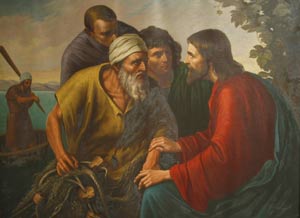
The Synoptic Gospels states that James and John were in a boat mending their nets with their father when Jesus called them to follow him. James was one of the favoured three who had the privilege of witnessing the Transfiguration (metamorphosis), the raising to life of the daughter of Jairus and the agony in Gethsemani.
His Journey to Evangelise Hispania
According to the Acts of the Apostles, after the death of Christ, the Apostles dispersed to different regions to take the Good News to the people of God. James along with seven disciples travelled to the Spanish peninsula, and specifically the NorthWestern land known at that time as Gallaecia, to spread the new Christian message of love, hope and brotherhood. With his great devotion to Jesus and his deep, unshakeable faith and strong temperament, he started to sow the seeds of this new religion, that will then survive so many centuries of routs and storms.
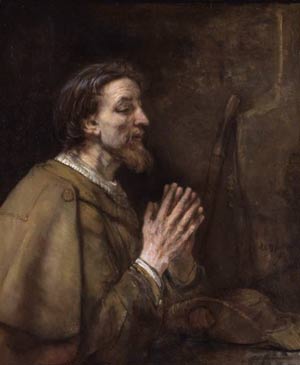
We must note however that writings of the voyage of James to Spain date from the sixth and ninth century AD. Historians have never been able to rigorously prove the presence of Saint James in Spain, nor describe the exact journey that he would have followed and there has been a lot of discussion within the Church on the authenticity of this trip. Even the authenticity of the relics at Compostela has been discussed over the century but was asserted in the Bull of Pope Leo XIII, Omnipotens Deus, of 1 November 1884.
The legend of the Virgin del Pilar in Zaragoza
An ancient legend found in a manuscript of the thirteenth century tells us that on 2 January AD 40 James was at Caesaraugusta, the current Zaragoza, quite discouraged by his lack of success in Aragon. The Virgin Mary appeared to him in flesh and bone on a marble pillar, and he found the new courage and enthusiasm he needed to convert people again.
She ordered him to build the first Christian Church around that same pillar, on the banks of the Ebro. This chapel, enlarged in the course of history is now the great basilica of the “Virgen del Pilar” (Notre Dame of the Pillar) where the supposed pillar is still venerated.

Today Pilar, in honour of this miracle, is one of the most common names for women in Spain, especially in Aragon. The “Virgen del Pilar” is the Patroness of Spain, the Spanish Civil Guard and the Hispanic world.
His Martyrdom
Shortly after this episode, he decided to return to Jerusalem to see the living Virgin Mary once more, leaving his seven disciples the task of continuing his work. Back in Judea, he continued his mission to preach Jesus’ message until, one day, around the year 44, he was arrested during a sermon, tortured and killed by sword on order of Herod Agripa I, King of Judea. He became the first Christian martyr and the only one described in the New Testament.
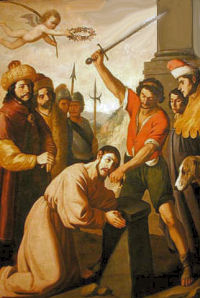
The journey back to Galicia to find the perfect burial site
It is said, his disciples, Atanasio and Teodomiro among with 5 other disciples, managed to retrieve his body and they set sail with it, from Jaffa to Iria Flavia on the Galician coast, on board a vessel made of stone. Legends say the voyage was beset with problems but accompanied by a celestial music and angels that filled the sky.
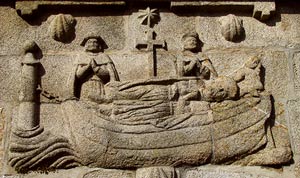
They are said to have entered Galicia by the Ría de Arousa, up the River Ulla and moored their boat on a stone column (a “pedron”) in Iria Flavia, whose name later became that of the present day town of Padron, 20km south of Santiago.
They deposited the body on another stone and it miraculously forming a Holy Sarcophagus.
The Queen Lupa
At the time, Iria Flavia belonged to the Queen Lupa who lived in the Castro Lupario (between the council of Brión and Teo). The disciples therefore went to ask for her help in order to find the perfect place to burry the mortal remains of the Apostle.
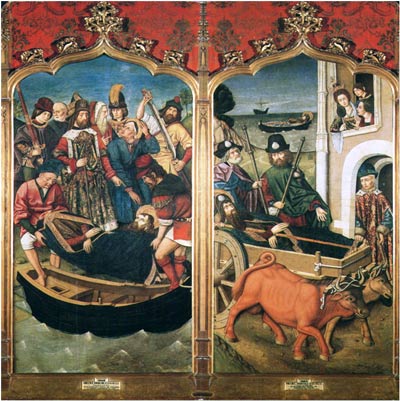
But the queen accused them of arrogance and sent them to the court of King Duyos, an enemy of Christianity, who imprisoned the two men, before they were freed by divine intervention. Queen Lupa then set off her troops after them. But a strange event occurred in the waters of the River Tambre which made her immediately abandon the pursuit and change her hostile attitude. She converted to Christianity, ordered the demolition of all Celtic places and gave the disciples an oxen and an ox-cart to carry James’ body.
How the last resting place of Saint James was chosen
Continuing their journey, the two disciples reached the mountain of Ilicinio (Picosacro) where they came upon some ancient stone tablets that had once belonged to a druid altar which they decided to carry along. Another legend speaks a dragon being transformed into the mountain of Picosacro after their passage.
They were not sure of where the most suitable place to bury James’ sacred remains might be. So they decided to let the oxen roam free and to bury him where the oxen finally came to a halt.
This is how once set free, the oxen walked until it found a spring where it paused momentarily to drink. This fountain still exists in the Rua do Franco in Santiago and although it cannot be accessed anymore its waters are said to be capable of curing eye diseases.

A few meters further, underneath an enormous oak tree, marked with the ancient altar stones of the druids, in the wood of Libredon is where Saint James the Greater is said to remain.

The centuries rolled by, chaotic, scarred by invasions and seemingly never-ending series of bloody wars all over Europe. And little by little the tomb of Saint James was forgotten. It was not until the year 813 that the hermit Pelayo had a vision which led to the rediscovery of the sacred burial site and the birth of the Camino de Santiago…